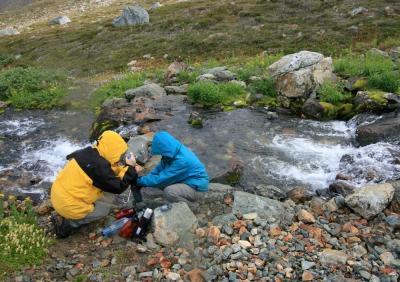How to find suitable water while camping

Clean water is an absolute necessity when spending time in the wilderness. Whether you’re camping, hiking, fishing, or participating in any number of outdoor activities, finding a safe source of water is imperative. There is always some risk of getting lost or hurt and without a water source, the chances of survival can be extremely low. The ability to find and purify water is a necessary skill for any outdoor enthusiast.
Whether you’re looking for a convenient source of water for your next hike or several days worth for an extended camping trip, the following guide will keep you safe and hydrated.
Campground Water
If you’re participating in an outdoor activity at a campsite, there may be a number of spigots located throughout the trails and campgrounds. This is the easiest source of water because there is an infinite supply and it will not require lugging around bottles or canteens full of stored water.
Make sure to check with the owners of the campsite to ensure that the water from the spigots are safe to drink. Occasionally campsites will provide water for cooking and cleaning that is not suitable for drinking.
Water Filters
There are a number of extremely effective water filters currently on the market. The best option for water filters are ceramic, because they ensure the water you drink is 99.9% free of foreign substances. This means that safe drinking water can be obtained from any source.
Water filters have a small tube which can be submerged in the water. You will need to use the pump to force the water through the filter. Water filters can be time consuming, but extremely valuable on extended camping trips because of their effectiveness at purifying water.
A downside to water filters is that they can become clogged by dirty or muddy water. The filters can be cleaned, but if there is a shortage of clear water, it may be difficult to do so.
Iodine
Iodine is more convenient than water filters because it is lighter and simpler to use. The downside to iodine is that it cannot be used on water that is dirty or has visible foreign substances floating in it. This means iodine use is limited to clear, mostly clean water. The iodine will purify the water and rid it of any germs or bacteria.
Iodine comes in either tablets or drops and should be left in water for at least ten minutes before drinking.
Boiling
Boiling water is an effective way to kill germs and bacteria, but will not result in clear water. If murky water is boiled it will remain murky. Boiling water also does nothing to improve the taste. Mud, sand, and any foreign particles will not be removed, which makes boiling not a very viable solution for water that isn’t clear.
Another drawback to boiling is that it takes a fair amount of time and fuel. The boiling water must be poured in canteens and may take hours to cool down. It also takes the efforts of building a fire, which can slow down activities and waste energy.
Where to Find Water
The best water sources are those that are clear and running. Standing water will be full of dirt, foreign particles, germs, and bacteria. The faster the water is running, the more likely it is to be safe. Clear water is the easiest to purify and is by far the best option.
Planning Ahead
When choosing which method will be used to purify water, it’s important to plan ahead. Determine what sort of water sources will be available to you during your outdoor activity. If standing, murky water is the most likely source than investing in a ceramic water filter is likely to be your best option. If clear, running water will be available, than it may be best to use the much easier to carry iodine tablets.
The best way to avoid a water shortage is by planning ahead. Make sure you have everything you need to purify water. If you’re going on a long trip, it is best to bring additional water filters or back-up iodine. You never know what could happen when you’re out in the wilderness and being prepared will help reduce your risk of drinking impure water or suffering from dehydration.
